Chapter 10 Functional Dependencies and Normalization for Relational Databases
Bạn đang xem bản rút gọn của tài liệu. Xem và tải ngay bản đầy đủ của tài liệu tại đây (1.12 MB, 48 trang )
Chapter 10
Functional Dependencies and
Normalization for Relational
Databases
Chapter Outline
1 Informal Design Guidelines for Relational Databases
1.1Semantics of the Relation Attributes
1.2 Redundant Information in Tuples and Update Anomalies
1.3 Null Values in Tuples
1.4 Spurious Tuples
2 Functional Dependencies (FDs)
2.1 Definition of FD
2.2 Inference Rules for FDs
2.3 Equivalence of Sets of FDs
2.4 Minimal Sets of FDs
Chapter Outline(contd.)
3 Normal Forms Based on Primary Keys
3.1 Normalization of Relations
3.2 Practical Use of Normal Forms
3.3 Definitions of Keys and Attributes Participating in Keys
3.4 First Normal Form
3.5 Second Normal Form
3.6 Third Normal Form
4 General Normal Form Definitions (For Multiple
Keys)
5 BCNF (Boyce-Codd Normal Form)
1 Informal Design Guidelines for
Relational Databases (1)
What is relational database design?
The grouping of attributes to form "good" relation schemas
Two levels of relation schemas
–
The logical "user view" level
–
The storage "base relation" level
Design is concerned mainly with base relations
What are the criteria for "good" base relations?
Informal Design Guidelines for
Relational Databases (2)
We first discuss informal guidelines for good
relational design
Then we discuss formal concepts of functional
dependencies and normal forms
- 1NF (First Normal Form)
- 2NF (Second Normal Form)
- 3NF (Third Normal Form)
- BCNF (Boyce-Codd Normal Form)
Additional types of dependencies, further normal
forms, relational design algorithms by synthesis are
discussed in Chapter 11
1.1 Semantics of the Relation
Attributes
GUIDELINE 1: Informally, each tuple in a relation
should represent one entity or relationship instance.
(Applies to individual relations and their attributes).
Attributes of different entities (EMPLOYEEs, DEPARTMENTs,
PROJECTs) should not be mixed in the same relation
Only foreign keys should be used to refer to other entities
Entity and relationship attributes should be kept apart as much as
possible.
Bottom Line: Design a schema that can be explained
easily relation by relation. The semantics of
attributes should be easy to interpret.
Figure 10.1 A simplified COMPANY
relational database schema
Note: The above figure is now called Figure 10.1 in Edition 4
1.2 Redundant Information in
Tuples and Update Anomalies
Mixing attributes of multiple entities may cause
problems
Information is stored redundantly wasting storage
Problems with update anomalies
–
Insertion anomalies
–
Deletion anomalies
–
Modification anomalies
EXAMPLE OF AN UPDATE
ANOMALY (1)
Consider the relation:
EMP_PROJ ( Emp#, Proj#, Ename, Pname, No_hours)
Update Anomaly: Changing the name of project
number P1 from “Billing” to “Customer-
Accounting” may cause this update to be made for
all 100 employees working on project P1.
EXAMPLE OF AN UPDATE
ANOMALY (2)
Insert Anomaly: Cannot insert a project unless
an employee is assigned to .
Inversely - Cannot insert an employee unless an
he/she is assigned to a project.
Delete Anomaly: When a project is deleted, it
will result in deleting all the employees who work
on that project. Alternately, if an employee is the
sole employee on a project, deleting that employee
would result in deleting the corresponding project.
Figure 10.3 Two relation schemas
suffering from update anomalies
Note: The above figure is now called Figure 10.3 in Edition 4
Figure 10.4 Example States for EMP_DEPT
and EMP_PROJ
Note: The above figure is now called Figure 10.4 in Edition 4
Guideline to Redundant Information
in Tuples and Update Anomalies
GUIDELINE 2: Design a schema that does not
suffer from the insertion, deletion and update
anomalies. If there are any present, then note them
so that applications can be made to take them into
account
1.3 Null Values in Tuples
GUIDELINE 3: Relations should be designed such
that their tuples will have as few NULL values as
possible
Attributes that are NULL frequently could be
placed in separate relations (with the primary key)
Reasons for nulls:
–
attribute not applicable or invalid
–
attribute value unknown (may exist)
–
value known to exist, but unavailable
1.4 Spurious Tuples
Bad designs for a relational database may result in
erroneous results for certain JOIN operations
The "lossless join" property is used to guarantee
meaningful results for join operations
GUIDELINE 4: The relations should be designed to
satisfy the lossless join condition. No spurious
tuples should be generated by doing a natural-join
of any relations.
Spurious Tuples (2)
There are two important properties of decompositions:
(a) non-additive or losslessness of the corresponding
join
(b) preservation of the functional dependencies.
Note that property (a) is extremely important and
cannot be sacrificed. Property (b) is less stringent
and may be sacrificed. (See Chapter 11).
2.1 Functional Dependencies (1)
Functional dependencies (FDs) are used to specify
formal measures of the "goodness" of relational
designs
FDs and keys are used to define normal forms for
relations
FDs are constraints that are derived from the
meaning and interrelationships of the data attributes
A set of attributes X functionally determines a set of
attributes Y if the value of X determines a unique
value for Y
Functional Dependencies (2)
X -> Y holds if whenever two tuples have the same value
for X, they must have the same value for Y
For any two tuples t1 and t2 in any relation instance r(R): If
t1[X]=t2[X], then t1[Y]=t2[Y]
X -> Y in R specifies a constraint on all relation
instances r(R)
Written as X -> Y; can be displayed graphically on a
relation schema as in Figures. ( denoted by the arrow: ).
FDs are derived from the real-world constraints on the
attributes
Examples of FD constraints (1)
social security number determines employee name
SSN -> ENAME
project number determines project name and
location
PNUMBER -> {PNAME, PLOCATION}
employee ssn and project number determines the
hours per week that the employee works on the
project
{SSN, PNUMBER} -> HOURS
Examples of FD constraints (2)
An FD is a property of the attributes in the schema
R
The constraint must hold on every relation
instance r(R)
If K is a key of R, then K functionally determines
all attributes in R (since we never have two
distinct tuples with t1[K]=t2[K])
2.2 Inference Rules for FDs (1)
Given a set of FDs F, we can infer additional FDs
that hold whenever the FDs in F hold
Armstrong's inference rules:
IR1. (Reflexive) If Y subset-of X, then X -> Y
IR2. (Augmentation) If X -> Y, then XZ -> YZ
(Notation: XZ stands for X U Z)
IR3. (Transitive) If X -> Y and Y -> Z, then X -> Z
IR1, IR2, IR3 form a sound and complete set of
inference rules
Inference Rules for FDs (2)
Some additional inference rules that are useful:
(Decomposition) If X -> YZ, then X -> Y and X -> Z
(Union) If X -> Y and X -> Z, then X -> YZ
(Psuedotransitivity) If X -> Y and WY -> Z, then WX ->
Z
The last three inference rules, as well as any other
inference rules, can be deduced from IR1, IR2,
and IR3 (completeness property)
Inference Rules for FDs (3)
Closure of a set F of FDs is the set F
+
of all FDs
that can be inferred from F
Closure of a set of attributes X with respect to F is
the set X
+
of all attributes that are functionally
determined by X
X
+
can be calculated by repeatedly applying IR1,
IR2, IR3 using the FDs in F
2.3 Equivalence of Sets of FDs
Two sets of FDs F and G are equivalent if:
- every FD in F can be inferred from G, and
- every FD in G can be inferred from F
Hence, F and G are equivalent if F
+
=G
+
Definition: F covers G if every FD in G can be
inferred from F (i.e., if G
+
subset-of F
+
)
F and G are equivalent if F covers G and G covers F
There is an algorithm for checking equivalence of
sets of FDs
2.4 Minimal Sets of FDs (1)
A set of FDs is minimal if it satisfies the
following conditions:
(1) Every dependency in F has a single attribute for its RHS.
(2) We cannot remove any dependency from F and have a
set of dependencies that is equivalent to F.
(3) We cannot replace any dependency X -> A in F with a
dependency Y -> A, where Y proper-subset-of X
( Y subset-of X) and still have a set of dependencies that
is equivalent to F.
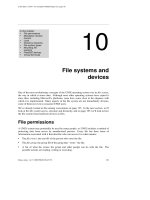
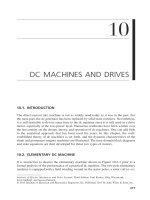

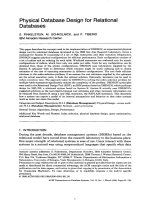
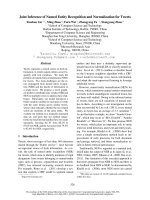
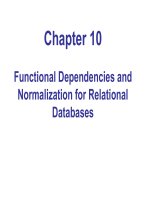


![[new] ensuring query correctness and completeness for outsourced databases](https://media.store123doc.com/images/document/2015_01/29/medium_oyb1422505634.jpg)
